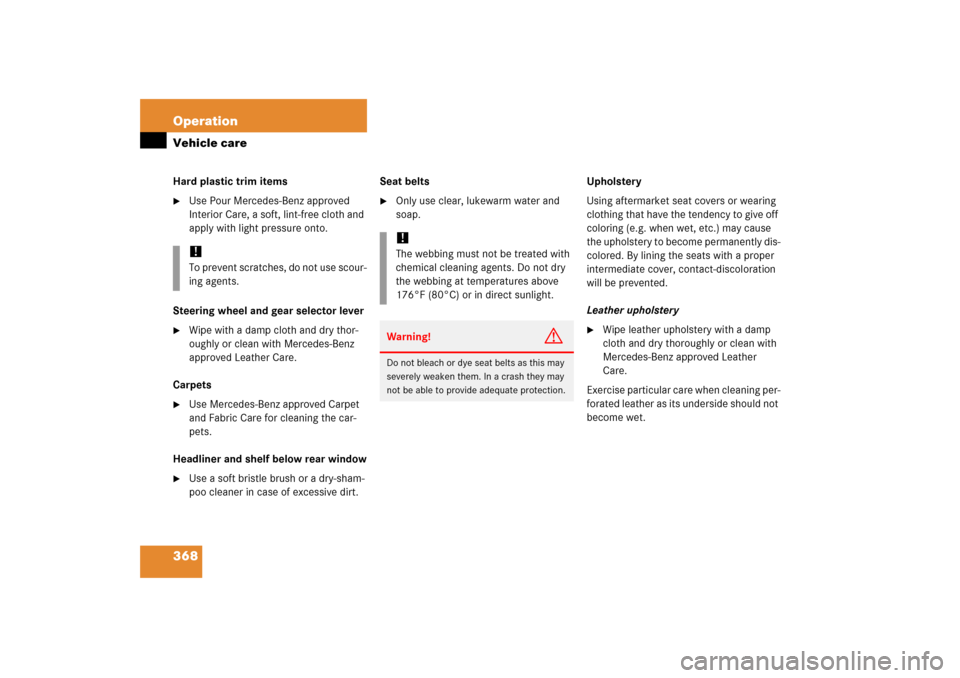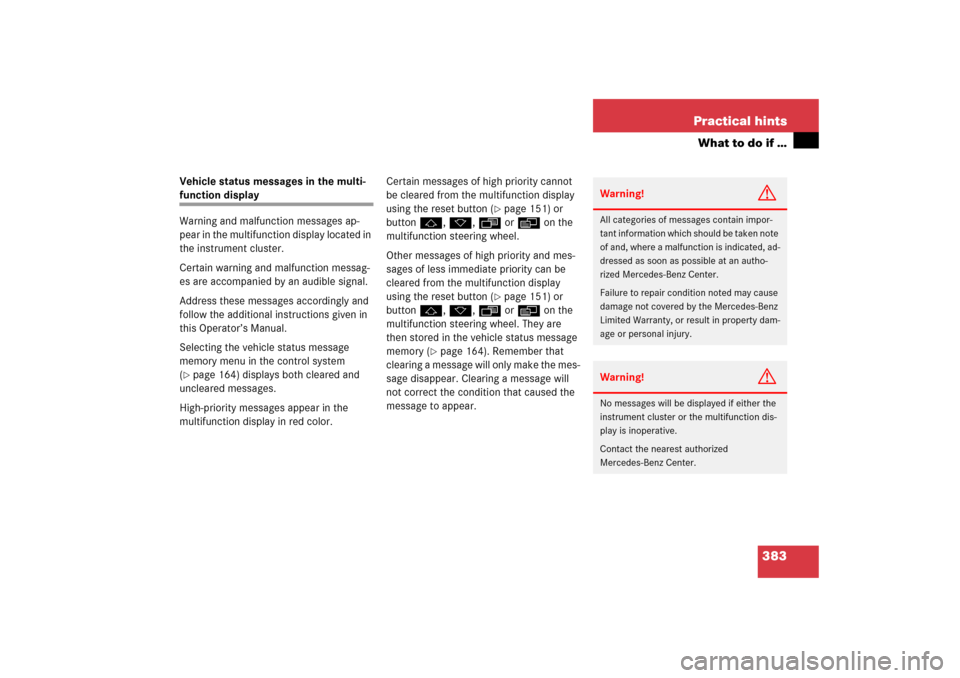Page 369 of 521

368 OperationVehicle careHard plastic trim items�
Use Pour Mercedes-Benz approved
Interior Care, a soft, lint-free cloth and
apply with light pressure onto.
Steering wheel and gear selector lever
�
Wipe with a damp cloth and dry thor-
oughly or clean with Mercedes-Benz
approved Leather Care.
Carpets
�
Use Mercedes-Benz approved Carpet
and Fabric Care for cleaning the car-
pets.
Headliner and shelf below rear window
�
Use a soft bristle brush or a dry-sham-
poo cleaner in case of excessive dirt. Seat belts
�
Only use clear, lukewarm water and
soap.Upholstery
Using aftermarket seat covers or wearing
clothing that have the tendency to give off
coloring (e.g. when wet, etc.) may cause
the upholstery to become permanently dis-
colored. By lining the seats with a proper
intermediate cover, contact-discoloration
will be prevented.
Leather upholstery
�
Wipe leather upholstery with a damp
cloth and dry thoroughly or clean with
Mercedes-Benz approved Leather
Care.
Exercise particular care when cleaning per-
forated leather as its underside should not
become wet.
!To prevent scratches, do not use scour-
ing agents.
!The webbing must not be treated with
chemical cleaning agents. Do not dry
the webbing at temperatures above
176°F (80°C) or in direct sunlight.Warning!
G
Do not bleach or dye seat belts as this may
severely weaken them. In a crash they may
not be able to provide adequate protection.
Page 370 of 521
369 Operation
Vehicle care
Nubuck leather upholstery (E 55 AMG)
The nubuck leather upholstery is treated
with a protective coating. �
Wipe nubuck leather upholstery with
damp microfiber cloth to remove dust
and other light stains.
�
Carefully dab nubuck leather uphol-
stery with a dry microfiber cloth to re-
move oil stains.Wood trims
�
Dampen cloth using water and use
damp cloth to clean wood trims in your
vehicle.
!Do not use Mercedes-Benz approved
Leather Care or any solvents to clean
nubuck leather upholstery.
Avoid hard scrubbing on nubuck leath-
er upholstery.
!Do not use solvents like tar remover or
wheel cleaner nor polishes or waxes as
these may be abrasive.
Page 373 of 521

372 Practical hintsWhat to do if …Lamps in instrument clusterGeneral information:
If any of the following lamps in the instru-
ment cluster fails to come on during thebulb self-check when switching on the igni-
tion, have the respective bulb checked and
replaced if necessary.Problem
Possible cause/consequence
Suggested solution
-
The yellow ABS indicator lamp
comes on while driving.
The ABS has detected a malfunction and has
switched off. The BAS and the ESP
® are also
switched off (see messages in multifunction
display).
The electrohydraulic brake system is still
functioning normally but without the ABS
available.
If the ABS control unit is malfunctioning, oth-
er systems such as Distronic*, or the auto-
matic transmission may also be
malfunctioning.
�
Continue driving with added caution.
Wheels may lock during hard braking,
reducing steering capability.
�
Read and observe messages in the
multifunction display (
�page 383).
�
Have the system checked at an autho-
rized Mercedes-Benz Center as soon
as possible.
Failure to follow these instructions in-
creases the risk of an accident.
The charging voltage has fallen below
10 volts. The ABS has switched off.
The battery may not be sufficiently charged.
�
Switch off electrical consumers that
are currently not needed, e.g. seat
heating.
�
If necessary, have the generator and
battery checked.
When the voltage is above this value
again, the ABS is operational again.
Page 380 of 521

379 Practical hints
What to do if …
Warning!
G
Each tire, including the spare (if provided),
should be checked monthly when cold and
inflated to the inflation pressure recom-
mended by the vehicle manufacturer on the
vehicle placard or the tire inflation pressure
label. (If your vehicle has tires of a different
size than the size indicated on the vehicle
placard or the tire inflation pressure label,
you should determine the proper tire infla-
tion pressure for those tires).
As an added safety feature, your vehicle has
been equipped with a tire pressure monitor-
ing system (TPMS) that illuminates a low tire
pressure telltale when one or more of your
tires is significantly under-inflated. Accord-
ingly, when the low tire pressure telltale illu-
minates, you should stop and check your
tires as soon as possible, and inflate them to
the proper pressure. Driving on a significant-
ly under-inflated tire causes the tire to over-
heat and can lead to tire failure.
Under-inflation also reduces fuel efficiency
and tire tread life, and may affect the vehi-
cle’s handling and stopping ability. Please
note that the TPMS is not a substitute for
proper tire maintenance, and it is the driv-
er’s responsibility to maintain correct tire
pressure, even if under-inflation has not
reached the level to trigger illumination of
the TPMS low tire pressure telltale.
Your vehicle has also been equipped with a
TPMS malfunction indicator to indicate
when the system is not operating properly.
The TPMS malfunction indicator is com-
bined with the low tire pressure telltale.
When the system detects a malfunction, the
telltale will flash for approximately
one minute and then remain continuously
illuminated. This sequence will continue
upon subsequent vehicle start-ups as long
as the malfunction exists. When the mal-
function indicator is illuminated, the system
may not be able to detect or signal low tire
pressure as intended.
TPMS malfunctions may occur for a variety
of reasons, including the installation of in-
compatible replacement or alternate tires or
wheels on the vehicle that prevent the TPMS
from functioning properly. Always check the
TPMS malfunction telltale after replacing
one or more tires or wheels on your vehicle
to ensure that the replacement or alternate
tires and wheels allow the TPMS to continue
to function properly.
Page 384 of 521

383 Practical hints
What to do if …
Vehicle status messages in the multi-function display
Warning and malfunction messages ap-
pear in the multifunction display located in
the instrument cluster.
Certain warning and malfunction messag-
es are accompanied by an audible signal.
Address these messages accordingly and
follow the additional instructions given in
this Operator’s Manual.
Selecting the vehicle status message
memory menu in the control system
(�page 164) displays both cleared and
uncleared messages.
High-priority messages appear in the
multifunction display in red color.Certain messages of high priority cannot
be cleared from the multifunction display
using the reset button (
�page 151) or
buttonj, k, ÿ or è on the
multifunction steering wheel.
Other messages of high priority and mes-
sages of less immediate priority can be
cleared from the multifunction display
using the reset button (�page 151) or
buttonj, k, ÿ or è on the
multifunction steering wheel. They are
then stored in the vehicle status message
memory (
�page 164). Remember that
clearing a message will only make the mes-
sage disappear. Clearing a message will
not correct the condition that caused the
message to appear.
Warning!
G
All categories of messages contain impor-
tant information which should be taken note
of and, where a malfunction is indicated, ad-
dressed as soon as possible at an autho-
rized Mercedes-Benz Center.
Failure to repair condition noted may cause
damage not covered by the Mercedes-Benz
Limited Warranty, or result in property dam-
age or personal injury.Warning!
G
No messages will be displayed if either the
instrument cluster or the multifunction dis-
play is inoperative.
Contact the nearest authorized
Mercedes-Benz Center.
Page 386 of 521
385 Practical hints
What to do if …
Text messagesDisplay
Display message
Possible cause/consequence
Possible solution
ABS
Malfunction
Visit workshop
The ABS has detected a malfunction
and has switched off.
The ESP
® and the BAS are also de-
activated.
The electrohydraulic brake system is
still functioning normally but without
the ABS available.
�
Continue driving with added caution.
Wheels will lock during hard braking, reduc-
ing steering capability.
�
Have the system checked at an authorized
Mercedes-Benz Center as soon as possible.
Failure to follow these instructions increases
the risk of an accident.
Display malfunction
Visit workshop
The ABS or the ABS display is
malfunctioning.
�
Continue driving with added caution.
Wheels will lock during hard braking, reduc-
ing steering capability.
�
Visit an authorized Mercedes-Benz Center
as soon as possible.
Failure to follow these instructions increases
the risk of an accident.
Page 389 of 521

388 Practical hintsWhat to do if …Display
Display message
Possible cause/consequence
Possible solution
ESP
Malfunction
Visit workshop
The ESP
® has detected a malfunc-
tion and switched off.
The ABS may not be operational.
The electrohydraulic brake system is
still functioning normally but without
the ESP® available.
�
Continue driving with added caution.
�
Have the system checked at an authorized
Mercedes-Benz Center as soon as possible.
Failure to follow these instructions increases
the risk of an accident.
unavailable
See Operator’s Manual
The ESP
® is deactivated because
the power supply was interrupted.
The electrohydraulic brake system is
still functioning normally but without
the ESP® available.
�
Synchronize the ESP
®. With the vehicle sta-
tionary, turn the steering wheel completely
to the left and then to the right to synchro-
nize the ESP
®.
If the ESP
® message does not go out:
�
Continue driving with added caution.
�
Have the system checked at an authorized
Mercedes-Benz Center as soon as possible.
Failure to follow these instructions increases
the risk of an accident.
!When synchronizing the ESP
®, make
sure you can turn the steering wheel in
both directions as far as it will go with-
out the wheels hitting any objects, e.g.
a road curb.
Page 395 of 521

394 Practical hintsWhat to do if …Display message
Possible cause/consequence
Possible solution
Tire pres. monitor
inoperative
The TPMS* is malfunctioning.
�
Have the TPMS* checked by an authorized
Mercedes-Benz Center.
Tire pres. monitor
inoperative
No wheel sensors
There are wheels without wheel sensors
mounted (e.g. winter tires).
�
Have the TPMS* checked by an authorized
Mercedes-Benz Center.
�
Have the wheel sensors installed by an authorized
Mercedes-Benz Center.
Tire pres. monitor
Wheel sensor missing
One or more sensors malfunction (e.g. bat-
tery in one or more wheel sensor is empty).
One or more wheels without wheel sensors
mounted (e.g. spare tire).
�
Have the TPMS* checked by an authorized
Mercedes-Benz Center.
�
Have the wheel sensors installed by an authorized
Mercedes-Benz Center.
The tire pressure for the respective tire is shown in the
multifunction display.
Tire pres. monitor
currently unavailable
The TPMS* is unable to monitor the tire
pressure due to�
a nearby radio interference source.
�
excessive wheel sensor temperatures.
�
As soon as the causes for the malfunction are no longer
present, the TPMS* automatically becomes active again
after a few minutes driving.